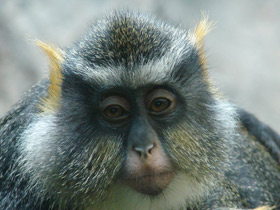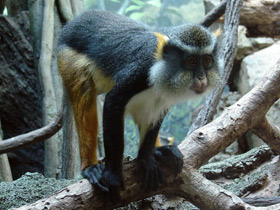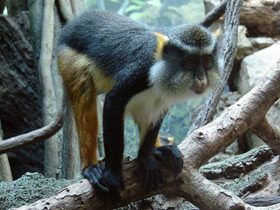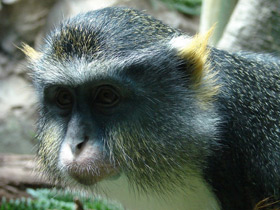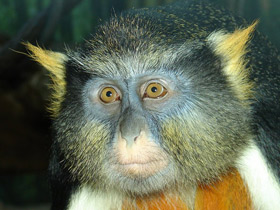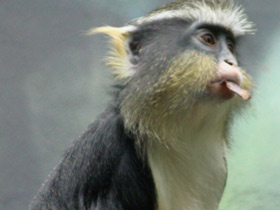Wolf's mona monkey or Wolf's guenon (Cercopithecus wolfi)
Wolf's mona monkey (Cercopithecus wolfi), also called Wolf's guenon, is a colourful Old World monkey in the family Cercopithecidae. It is found in central Africa, primarily between the Democratic Republic of the Congo and Uganda. It lives in primary and secondary lowland rainforest and swamp forest.
Taxonomy
The species was first described from a living specimen in the Zoological Garden at Dresden. It was brought in 1887 by Dr Ludwig Wolf from somewhere in central west Africa. The species was described in 1891 and named after the collector. This specimen died in October 1891 and the skeletal characteristics were described in 1894.
Wolf's mona monkey is in the C. mona grouping within the genus Cercopithecus along with Campbell's mona monkey, Dent's mona monkey, Lowe's mona monkey, the mona monkey, and the crested mona monkey. Wolf's mona monkey was previously considered a subspecies of the crested mona monkey. The genus Cercopithecus is part of the subfamily Cercopithecinae along with baboons, mangabeys, and macaques. This subfamily shares several common traits such as cheek pouches, low and rounded molar cusps, and simple stomachs; all adaptations to a frugivorous diet.
Wolf's mona monkey has two subspecies which are separated by a large area of swamp forest:
- Cercopithecus wolfi wolfi, found between the Congo and Sankuru Rivers.
- Cercopithecus wolfi elegans, found between the Lomami and Lualaba Rivers.
Appearance and habitat
Cercopithecus wolfi is a species of catarrhine primate of the family Cercopithecidae. Cercopithecus wolfi is found in central Africa, mainly in the Democratic Republic of Congo and Uganda, where it inhabits primary and secondary rainforests and swamp forests.
The species was described in 1891 and named after Ludwig Wolf, who captured the animal for the Dresden Zoo. The fur of Cercopithecus wolfi wolfi is grey and reddish on the back, while the subspecies Cercopithecus wolfi wolfi wolfi has a brown mark on the back. The arms of this monkey are black, the legs reddish; the abdomen yellow, flanked by orange. The wool on the cheeks and ears is long and light yellow. The species is sexually dimorphic: males weigh about 4.5 kg and females up to 2.5 kg.
Nutrition
Its diet consists mainly of fruit, but also seeds, flowers, nectar and insects. Leaves and shoots are sometimes included in their diet, however, because monkeys have no special adaptations for eating vegetation, they choose only young leaves.
Lifestyle and social behaviour
Cercopithecus wolfi are diurnal animals. They move around a lot and catch insects mainly in the morning and rest in the afternoon. The groups of monkeys spend approximately 40% of their time in the treetops at a height of 15-20 m and 31% of their time at a height of 20-25 m.
These primates form groups with an average size of 12 animals, consisting of a sexually mature male, several females and offspring. Cercopithecus wolfi reacts very aggressively to the appearance of individuals of its own species in the group's territory, and not only the males but also the females show aggression. The breeding season starts in June and ends in December. Males leave the group when they reach sexual maturity.









